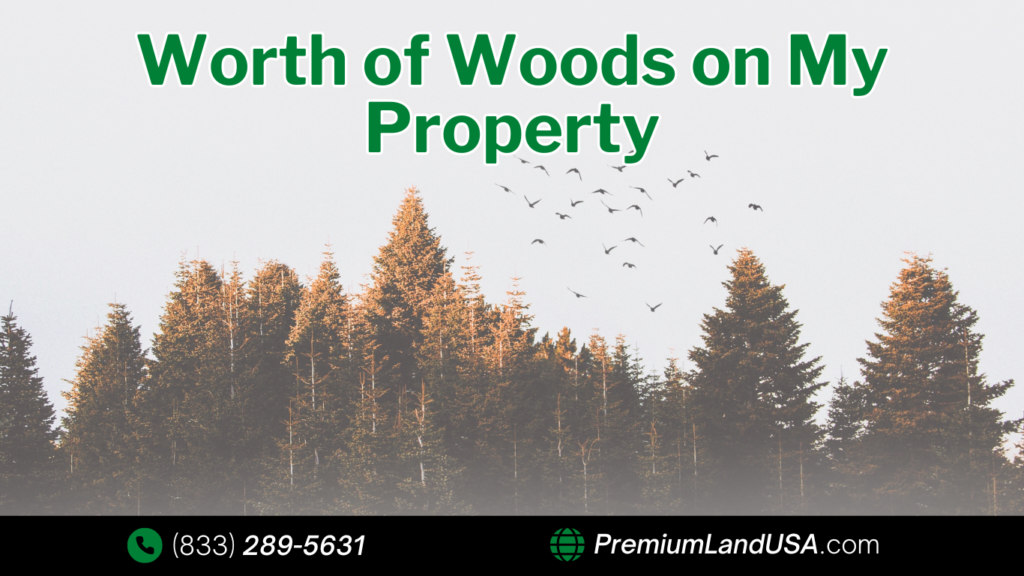If you own wooded property, you might be sitting on an untapped financial resource. Whether you’re considering selling timber, leasing your land for recreational purposes, or simply evaluating its market value, understanding the worth of the woods on your property is essential.
1. Timber Value
One of the most obvious sources of value in wooded property is the timber. Different tree species have different market values, and the age, size, and quality of the trees play a significant role in determining their worth. Hardwoods like oak, walnut, and cherry often fetch higher prices, while softwoods like pine are valuable for construction and paper products. Consulting a professional forester can provide a precise estimate of your timber’s value.
Timber Harvesting Options
When it comes to harvesting timber, there are different methods to consider. Clear-cutting removes all trees in an area, while selective harvesting removes only specific trees, allowing the forest to regenerate naturally. Each method has pros and cons, and the right choice depends on your long-term goals and the health of your forest.
Sustainable Forestry Practices
Sustainable forestry ensures that timber harvesting does not deplete your land’s resources. Techniques such as replanting and rotational harvesting are key to maintaining a productive forest for generations. Many buyers value properties with a history of sustainable management. (National Forest Foundation)
2. Recreational Leasing
Many landowners generate income by leasing their wooded properties for hunting, camping, or hiking. Hunters often pay a premium for exclusive access to private land abundant with wildlife. Additionally, outdoor enthusiasts and campers might be interested in short-term rentals.
Wildlife Management
Well-managed forests attract more wildlife, increasing the value of your land for recreational leasing. Food plots, water sources, and shelter areas can create an appealing environment for deer, turkey, and other game animals.
Short-Term Rentals
Platforms like Airbnb and Hipcamp allow landowners to earn money by offering their wooded properties for camping or glamping experiences. These short-term stays are popular among city dwellers seeking a break in nature. (Hipcamp)
3. Conservation Programs
In some cases, your woods might qualify for conservation programs. Federal and state initiatives often provide financial incentives for landowners who agree to preserve forests, prevent deforestation, or promote wildlife habitats. Programs like these not only offer financial benefits but also protect your land for future generations.
Tax Incentives
Many conservation programs offer tax incentives for landowners who commit to protecting their forests. These incentives can significantly offset property taxes or provide additional income. (USDA Forest Service)
4. Carbon Credits
As environmental concerns grow, carbon credit markets have emerged as a way for landowners to earn money by keeping trees standing. Companies looking to offset their carbon emissions may pay you for maintaining your forest as a carbon sink.
How Carbon Credits Work
Each carbon credit represents one metric ton of carbon dioxide absorbed by your trees. Third-party organizations verify and certify these credits, which are then sold on carbon markets.
Long-Term Agreements
Carbon credit agreements often require long-term commitments, sometimes decades-long, to ensure forests are protected and continue absorbing carbon. (Carbon Offset Guide)
5. Aesthetic and Residential Appeal
Wooded properties are often more appealing to buyers looking for privacy, natural beauty, or a scenic retreat. The presence of mature trees can significantly increase the market value of your land.
Building Potential
Wooded properties offer unique building opportunities, including cabin retreats, eco-friendly homes, or vacation rentals. Buyers looking for such opportunities are often willing to pay a premium. (National Association of Realtors)
6. Responsible Management is Key
Whether you’re considering timber harvesting, recreational leasing, or conservation programs, responsible management is crucial. Poorly managed logging or land misuse can damage ecosystems, reduce long-term profitability, and lower property value.
Hiring Professionals
Consulting with foresters, conservation experts, and land management professionals can help you make informed decisions about your property. They can guide you on how to maximize your land’s value without compromising its health. (Society of American Foresters)
7. Additional Revenue Streams
Beyond the traditional avenues of timber sales and recreational leasing, there are other ways to generate income from your wooded property:
- Non-Timber Forest Products: Mushrooms, herbs, berries, and other forest products can be harvested and sold.
- Beekeeping: Wooded areas are ideal for beekeeping, and honey production can become a profitable venture.
- Photography and Event Hosting: Scenic wooded properties are often in demand for photography sessions, weddings, or corporate retreats. (Agroforestry Practices)
Conclusion
The woods on your property can indeed be a valuable asset, but understanding the different avenues for monetization is key. Whether it’s through timber sales, recreational leasing, conservation programs, carbon credits, or alternative revenue streams, your forested land holds potential worth exploring. Partnering with professionals like foresters, conservationists, or real estate experts can help you maximize your return while preserving the natural beauty of your property.
If you’re considering selling or monetizing your wooded property, contact us at Premium Land USA for expert guidance and support!
References:
- National Forest Foundation – Sustainable Forestry: Focuses on sustainable forest management practices.
- Hipcamp – Landowner Benefits: Outlines benefits for landowners offering recreational land use.
- USDA Forest Service – Conservation Programs: Explains conservation incentives and financial programs.
- Carbon Offset Guide: Provides information on carbon credit markets.
- National Association of Realtors – Land Use Trends: Discusses land trends and residential appeal.
- Society of American Foresters: Offers guidance on responsible forest management.
- Agroforestry Practices: Highlights alternative revenue opportunities from forest products.

